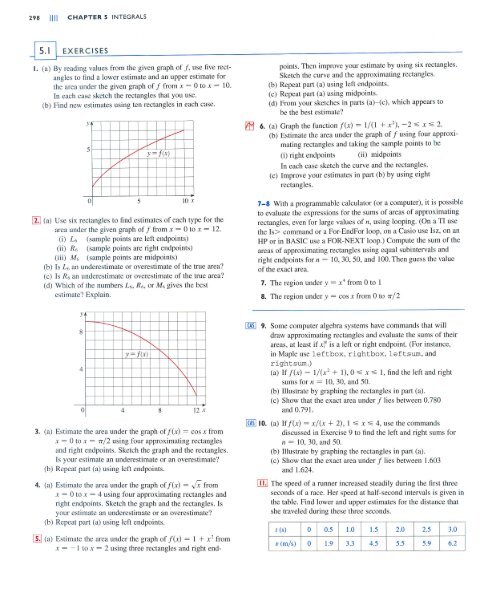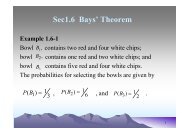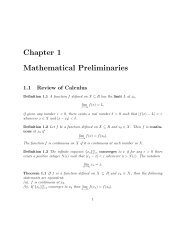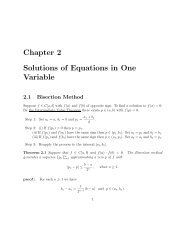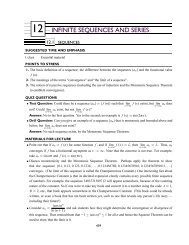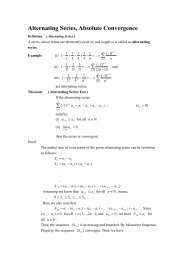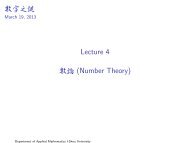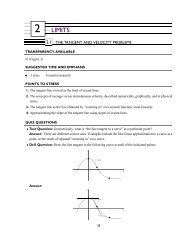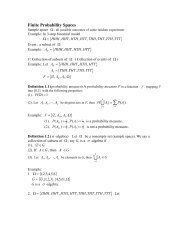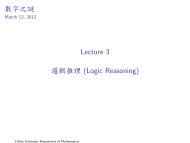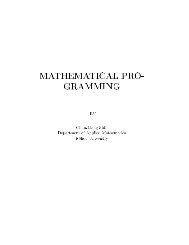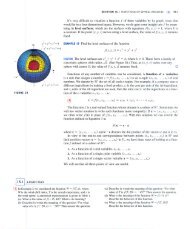Is:f(x) dx
Is:f(x) dx
Is:f(x) dx
- No tags were found...
You also want an ePaper? Increase the reach of your titles
YUMPU automatically turns print PDFs into web optimized ePapers that Google loves.
12. Speedometer readings for a motorcycle at l2-second intervalsare given in the table.(a) Estimate the distance traveled by the motorcycle duringthis time period using the velocities at the beginning ofthe time intervals.(b) Give another estimate using the velocities at the end ofthe time periods.(c) Are your estimates in parts (a) and (b) upper and lowerestimates? Explain.t (s) 0 12 24 36 48 60v (m/s) 9.1 8.5 7.6 6.7 7.3 8.213. Oil leaked from a tank at a rate of ref) liters per hour. Therate decreased as time passed and values of the rate at twohourtime intervals are shown in the table. Find lower andupper estimates for the total amount of oil that leaked out.t (h) 0 2 4 6 8 10r(t) (L/h) 8.7 7.6 6.8 6.2 5.7 5.314. When we estimate distances from velocity data, it is sometimesnecessary to use times to, t), f2, f3, ... that are notequally spaced. We can still estimate distances using the timeperiods t::.ti = ti - fi-I. For example, on May 7, 1992, thespace shuttle Endeavour was launched on mission STS-49,the purpose of which was to install a new perigee kick motorin an Intelsat communications satellite. The table, providedby NASA, gives the velocity data for the shuttle betweenliftoff and the jettisoning of the solid rocket boosters. Usethese data to estimate the height above the earth's surface ofthe Endeavour, 62 seconds after liftoff.16. The velocity graph of a car accelerating from rest to a speedof 120 km/h over a period of 30 seconds is shown. Estimatethe distance traveled during this period.u--Ih)-----8040/////0 10 20 30 tseco17-19 Use Definition 2 to find an expression for the area underthe graph of f as a limit. Do not evaluate the limit.17. f(x) = $, I ~ x ~ 1618. f(x) = I + x 4 , 2 ~ x ~ 519. f(x) = xcosx, 0 ~ x ~ 7T/220-21 Determine a region whose area is equal to the given limit.Do not evaluate the limit." 2 ( 2i)IO20. lim 2: - 5 + -1/---+00 i=1 n nIl 7T i7T[Q lim 2: - tan-II--HtJ ;=1 4n 4nEvent Time (s) Velocity (m/s)Launch 0 0Begin roll maneuver 10 56End roll maneuver 15 97Throttle to 89% 20 136Throttle to 67% 32 226Throttle to 104% 59 404Maximum dynamic pressure 62 440Solid rocket booster separation 125 126515. The velocity graph of a braking car is shown. Use it to estimatethe distance traveled by the car while the brakes areapplied.u(m/s)156 t(seconds)22. (a) Use Definition 2 to find an expression for the area underthe curve y = x 3 from 0 to 1 as a limit.(b) The following formula for the sum of the cubes of thefirst n integers is proved in Appendix E. Use it to evaluatethe limit in part (a).1 [ n(n+I)]23 + 2 3 + 3 3 + ... + n 3 = 2ITill23. (a) Express the area under the curve y = x 5 from 0 to 2 asa limit.(b) Use a computer algebra system to find the sum in yourexpression from part (a).(c) Evaluate the limit in part (a).ITill24. (a) Express the area under the curve y = x 4 + 5x 2 + x from2 to 7 as a limit.(b) Use a computer algebra system to evaluate the sum inpart (a).(c) Use a computer algebra system to find the exact area byevaluating the limit of the expression in part (b).
IT&J 25. Find the exact area under the cosine curve y = cos x fromx = 0 to x = b, where 0 .; b .; 71/2. (Use a computer algebrasystem both to evaluate the sum and compute the limit.)In particular, what is the area if b = 7T/2?into n congruent triangles with central angle 27T/n, showthat26. (a) Let All be the area of a polygon with n equal sidesinscribed in a circle with radius r. By dividing the polygon=================~ THE DEFINITE INTEGRALWe saw in Section 5.1 that a limit of the formOJIIlim L f(xT) Lh = lim [J(xt) Llx + f(xi) Llx + ... + f(x,f) Llx]n~OOn----"'OO ;= Iarises when we compute an area. We also saw that it arises when we try to find the distancetraveled by an object. It turns out that this same type of limit occurs in a wide varietyof situations even when f is not necessarily a positive function. In Chapters 6 and 9 wewill see that limits of the form (1) also arise in finding lengths of curves, volumes of solids,centers of mass, force due to water pressure, and work, as well as other quantities. Wetherefore give this type of limit a special name and notation.[I] DEFINITION OF A DEFINITE INTEGRAL If f is a function defined for a ::;; x ::;; b,we divide the interval [a, b] into n subintervals of equal width Llx = (b - a)/n.We let Xo (= a), Xl, X2, •.. , Xn ( = b) be the endpoints of these subintervals and welet x~, xi, ... , x,f be any sample points in these subintervals, so xI lies in the ithsubinterval [Xi-I, Xi]. Then the definite integral of f from a to b isCbIIJa f(x) <strong>dx</strong> = ,~~i~ f(xt) Llx<strong>Is</strong>: f(x) <strong>dx</strong> - it,f(xt) ~xl < effiQ[JJ The symbol S was introduced by Leibniz and is called an integral sign. It isan elongated S and was chosen because an integral is a limit of sums. In the notationS:f(x) <strong>dx</strong>, f(x) is called the integrand and a and b are called the limits of integration;a is the lower limit and b is the upper limit. For now, the symbol <strong>dx</strong> has no meaningby itself; S:f(x) <strong>dx</strong> is all one symbol. The <strong>dx</strong> simply indicates that the independent variableis x. The procedure of calculating an integral is called integration.
§ EXERCISESI. Evaluate the Riemann sum for f(x) = 2 - x 2 , 0 ,,:; X ,,:; 2,with four subintervals, taking the sample points to be rightendpoints. Explain, with the aid of a diagram, what theRiemann sum represents.2. If f(x) = 3x - 7,0 ,,:;x ,,:; 3, evaluate the Riemann sumwith n = 6, taking the sample points to be left endpoints.What does the Riemann sum represent? Illustrate with adiagram.3. If f(x) = ;; - 2, 1 ,,:; x ,,:; 6, find the Riemann sum withn = 5 correct to six decimal places, taking the sample pointsto be midpoints. What does the Riemann sum represent?Illustrate with a diagram.4. (a) Find the Riemann sum for f(x) = sin x, 0 ,,:;x ,,:; 377/2,with six terms, taking the sample points to be rightendpoints. (Give your answer correct to six decimalplaces.) Explain what the Riemann sum represents withthe aid of a sketch.(b) Repeat part (a) with midpoints as sample points.lIJ The graph of a function f is given. Estimate J~f(x) <strong>dx</strong> usingfour subintervals with (a) right endpoints, (b) left endpoints,and (c) midpoints.y,/ \ ff-] \/ '\\ /0 I \ Ix\/6. The graph of 9 is shown. Estimate f3 g(x) <strong>dx</strong> with six subintervalsusing (a) right endpoints, (b) left endpoints, and(c) midpoints.'"0 I'" / ,I16. Use a calculator or computer to make a table of values ofleft and right Riemann sums L" and R" for the integral"'- /I"-. '/"- ../ numbers must the value of the integral lie? Can you make asimilar statement for the integral J~Ij1+X4 <strong>dx</strong>? Explain.7. A table of values of an increasing function f is shown. Usethe table to find lower and upper estimates for J~5f(x) <strong>dx</strong>.x 0 5 10 15 20 25f(x) -42 -37 -25 -6 15 36x 3 4 5 6 7 8 9[I .5 x-III. Jo sm(x 12. --<strong>dx</strong>,I) <strong>dx</strong>, n = 5I X + 1n= 4[ill] 13. If you have a CAS that evaluates midpoint approximations0.306 < [IJosin(x 2 ) <strong>dx</strong> < 0.315y,15. Use a calculator or computer to make a table of values ofright Riemann sums R" for the integral Jo'" sin x <strong>dx</strong> withn = 5, 10, 50, and 100. What value do these numbersto be approaching?gjj\ /\ /"18. The table gives the values of a function obtained from anexperiment. Use them to estimate J:f(x) <strong>dx</strong> using three equalsubintervals with (a) right endpoints, (b) left endpoints, and(c) midpoints. If the function is known to be an increasingfunction, can you say whether your estimates are less than orgreater than the exact value of the integral?j(x) -3.4 -2.1 -0.6 0.3 0.9 1.4 1.89-12 Use the Midpoint Rule with the given value of n to approximatethe integral. Round the answer to four decimal places.10. 50'" sec(x/3) <strong>dx</strong>, n = 6and graphs the corresponding rectangles (use middlesumand middlebox commands in Maple), check the answer toExercise 11 and illustrate with a graph. Then repeat withn = 10 and n = 20.14. With a programmable calculator or computer (see the instructionsfor Exercise 7 in Section 5.1), compute the left and rightRiemann sums for the function f(x) = sin(x 2 ) on the interval[0, 1] with n = 100. Explain why these estimates show thatDeduce that the approximation using the Midpoint Rule withn = 5 in Exercise 11 is accurate to two decimal places.appearJ~j1+X4 <strong>dx</strong> with n = 5, 10,50, and 100. Between what two
17-20 Express the limit as a definite integral on the giveninterval." I - x 217. lim 2: --'2 ~x, [2,6JII~OOi=1 4 + Xi. n COS Xi18. hm 2:--~x, [7T,27TJ,,_::>::;=) Xi"IT!l lim 2: .J2xt + (xtJ2 ~x, [I, 8]II_X;=\20."lim 2: [4 - 3(x7)2 + 6(xt) s J ~x, [0, 2Jf/_ X ;=121-25 Use the form of the definition of the integral given inTheorem 4 to evaluate the integral.(c) rf(x) <strong>dx</strong> (d) J:f(x) <strong>dx</strong>y2/1/ \y=f(x)\0 2 4 \6 8 x\ .,...- V34. The graph of 9 consists of two straight lines and a semicircle.Use it to evaluate each integral.(a) So2g(x) <strong>dx</strong> (b) r g(x) <strong>dx</strong> (c) S07g(x) <strong>dx</strong>21.[(l+ 3x)<strong>dx</strong>22. f(x 2 + 2x - 5)<strong>dx</strong>~ So2 (2 - x 2 ) <strong>dx</strong>24. S: (I + 2x 3 ) <strong>dx</strong>25. fx3<strong>dx</strong>26. (a) Find an approximation to the integral f0 4 (x 2 - 3x) <strong>dx</strong>using a Riemann sum with right endpoints and n = 8.(b) Draw a diagram like Figure 3 to illustrate the approximationin part (a).(c) Use Theorem 4 to evaluate j~(x 2 - 3x) <strong>dx</strong>.(d) Interpret the integral in part (c) as a difference of areasand illustrate with a diagram like Figure 4.fb b2 - (/227. Prove that x<strong>dx</strong> = ---fa 2b b3 - (/328. Prove that x 2 <strong>dx</strong> = ---a 329-30 Express the integral as a limit of Riemann sums. Do notevaluate the limit.29.f 6 x---5 <strong>dx</strong>2 I + x30. [2'" x 2 sin x <strong>dx</strong>.10[ill] 31-32 Express the integral as a limit of sums. Then evaluate,using a computer algebra system to find both the sum and thelimit.31. S: sin 5x <strong>dx</strong>f lO32. 2 x 6 <strong>dx</strong>~ The graph of f is shown. Evaluate each integral by interpretingit in terms of areas.(a) S02f(x) <strong>dx</strong> (b) S;t(x) <strong>dx</strong>35. f (l + 2x) <strong>dx</strong> 36. t~<strong>dx</strong>[ill f3(1 + ~)<strong>dx</strong>38. [(3 - 2x) <strong>dx</strong>39. t Ixl <strong>dx</strong> 40.r0lx-5 l <strong>dx</strong>41. Evaluate S: sin 2 x cos 4 x <strong>dx</strong>.42. Given that SOl3x#+4 <strong>dx</strong> = 5$ - 8, what isf3u#+4du?43. In Example 2 in Section 5.1 we showed that j~x 2 <strong>dx</strong> = ~.Use this fact and the properties of integrals to eval uatej~(5 - 6x 2 ) <strong>dx</strong>.44. Use the properties of integrals and the result of Example 3 toevaluate fi (l + 3x 4 ) <strong>dx</strong>.45. Use the results of Exercises 27 and 28 and the properties ofintegrals to evaluate J~(2x 2 - 3x + I) <strong>dx</strong>.46. Use the result of Exercise 27 and the fact thatj~"'/2cos x <strong>dx</strong> = I (from Exercise 25 in Section 5.1),together with the properties of integrals, to evaluatef;/2 (2 cos x - 5x) <strong>dx</strong>.
f2 f(x) <strong>dx</strong> + S: f(x) <strong>dx</strong> - [1 f(x) <strong>dx</strong>48. If S~f(x) <strong>dx</strong> = 12 and j; f(x) <strong>dx</strong> = 3.6, find S~f(x) <strong>dx</strong>.1m If j~f(x)<strong>dx</strong> = 37 and S~g(x) <strong>dx</strong> = 16, findj~[2f(x) + 3g(x)] <strong>dx</strong>.=eSO. Find J~f(x) <strong>dx</strong> ifforf(x)x < 3for X"" 35 I. Suppose f has absolute minimum value m and absolute maximumvalue M. Between what two values must S; f(x) <strong>dx</strong>lie? Which property of integrals allows you to make yourconclusion?52-54 Use the properties of integrals to verify the inequality withoutevaluating the integrals.52. fo l ~ <strong>dx</strong>~ fal ~ <strong>dx</strong>[ill 2~ [ ~<strong>dx</strong> ~ 2J2J2 7T S"/4 J3 7T54. -- ~ cosx<strong>dx</strong> ~--24 ,,/6 2455. f ..;; <strong>dx</strong> 56. C 2 __ 1_ <strong>dx</strong>Jo I + x 261- 62 Use properties of integrals, together with Exercises 27 and28, to prove the inequality.'3 2661. j JX4+1 <strong>dx</strong> ""-I 363. Prove Property 3 of integrals.64. Prove Property 6 of integrals.65. If f is continuous on [a, b], show thatIrf(x) <strong>dx</strong> I ~ s: I f(x) I <strong>dx</strong>,,/2 7T 262. fax sin x <strong>dx</strong> ~ 8IS:"f(x) sin 2x <strong>dx</strong> I ~ f0 2 " I f(x) I <strong>dx</strong>67. Letf(x) = 0 if x is any rational number andf(x) = I if x isany irrational number. Show thatfis not integrable on [0, I].68. Letf(O) = 0 andf(x) = l/x if 0 < x ~ 1. Show thatfis notintegrable on [0, I]. [Hint: Show that the first term in theRiemann sum, f(x!) ~x, can be made arbitrarily large.)69.• 1/ ihm L j4[Hint: Consider f(x) = x 4 .)/1--"'00 i=l n'I" I70. Jim - L / 2,,~OO n i~1 1 + (i n)57.f "/3 tan x<strong>dx</strong>,,/458. S02 (x 3 - 3x + 3) <strong>dx</strong>71. Find SI 2 x -2 <strong>dx</strong>. Hint: Choose xt to be the geometric mean ofXi-I and Xi (that is, xt = JXi-IXi ) and use the identity59. [J1h4 <strong>dx</strong>S O"60. ~ (x - 2 sin x) <strong>dx</strong>Im(m + I)DISCOVERYPROJECTI. (a) Draw the line y = 2t + I and use geometry to find the area under this line, above thet-axis, and between the vertical lines t = I and t = 3.(b) If x> 1, let A(x) be the area of the region that lies under the line y = 2t + I betweent = I and t = x. Sketch this region and use geometry to find an expression for A(x).(c) Differentiate the area function A(x). What do you notice?2. (a) If x "" -1, letA(x) =t (1 + t 2 ) dt
sin x if 0,,;; x < 71/253. The Fresnel function S was defined in Example 3 and35. J~" f(x) <strong>dx</strong> wheref(x) = {graphed in Figures 7 and 8.x if cos TT/2 ,,;;x ,,;;TT(a) At what values of x does this function have local maximum52. Find the interval on which the curve y = Ix 1 dtis concave upward. Jo 1 + t + t 236. C f(x) <strong>dx</strong> where f(x)values?2 if -2";; x";; 0= { 4-x2'f 0 2(b) On what intervals is the function concave upward?1
57-58 Evaluate the limit by first recognizing the sum as aRiemann sum for a function defined on [0, 1].n i 357. lim 2: 4lI---'i>lXl ;=1 n58. lim 2- ( !I + !i + !I + ... + G)n _?C n 'J -;; 'J -;; 'J -;; 'J-;;60. If f is continuous and 9 and h are differentiable functions,find a formula for~ [hex) f(t) dt<strong>dx</strong> J9(x)61. (a) Show that I ~ ~ ~ 1 + x 3 for x ~ o.(b) Show that I ~ J~~ <strong>dx</strong> ~ 1.25.62. (a) Show that cos(x 2 ) ~ cos x for 0 ~ x ~ I.(b) Deduce that J~"'/6cos(x 2 ) <strong>dx</strong> ~ 4.1 1 0 X2o~ -----<strong>dx</strong>~O.15 x 4 + x 2 +is overhauled, the company wants to determine the optimaltime T (in months) between overhauls.(a) Explain why J~f(s) ds represents the loss in value of themachine over the period of time t since the last overhaul.(b) Let C = C(t) be given byC(t) = +[A + f>(s) dS]What does C represent and why would the company wantto minimize C?(c) Show that C has a minimum value at the numbers t = Twhere C(T) = f(T).68. A high-tech company purchases a new computing systemwhose initial value is V. The system will depreciate at the ratef = f(t) and will accumulate maintenance costs at the rate9 = get), where t is the time measured in months. The companywants to determine the optimal time to replace the system.(a) LetC(t) = - I if [f(s) + g(s)) dst 0Show that the critical numbers of C occur at the numberst where C(t) = f(t) + get).(b) Suppose thatVVf(t) = ~5 - 450 t{f(x) = { ~~-xif x < 0if 0 ~ x ~ 1if I < x ~ 2if x> 2g(x) = foX f(t) dt(a) Find an expression for g(x) similar to the one for f(x).(b) Sketch the graphs of f and g.(c) Where is f differentiable? Where is 9 differentiable?Determine the length of time T for the total depreciationD(t) = S~f(s) ds to equal the initial value V.(c) Deterrillne the absolute minimum of C on (0, T].(d) Sketch the graphs of C and f + 9 in the same coordinatesystem, and verify the result in part (a) in this case.The following exercises are intended only for those who havealready covered Chapter 7.66. Suppose h is a function such that h(l) = -2, h'(l) = 2,h"(I) = 3, h(2) = 6, h'(2) = 5, h"(2) = 13, and h" is continuouseverywhere. Evaluate S; h"(u) duo67. A manufacturing company owns a major piece of equipmentthat depreciates at the (continuous) ratef= f(t), wheret is the time measured in months since its last overhaul.Because a fixed cost A is incurred each time the machine69.r l -<strong>dx</strong> 70. fo' lOX <strong>dx</strong>, 2x71. fJ3/2 6dt 72. r --dt41/2 ~ o t 2 + I73. f, e"+' dur 4 + u 274. ---du, u 369-74 Evaluate the integral.
EXAMPLE 7 Figure 4 shows the power consumption in the province of Ontario, Canada,for December 9, 2004 (P is measured in megawatts; t is measured in hours starting atmidnight). Estimate the energy used on that day.p"I'-h/r---r'-.~1('[,.- f.'- \\I 1\I I I I I 1 I I I I I I I I I I I 16 9 12 15 18 21 tSOLUTION Power is the rate of change of energy: pet) = E'(t). So, by the Net ChangeTheorem,(24 (24Jo pet) dt = Jo E'(t) dt = E(24) - E(O)is the total amount of energy used on that day. We approximateusing the Midpoint Rule with 12 subintervals and at = 2:the value of the integralS:4 pet) dt = [P(\) + P(3) + P(5) + ... + P(21) + P(23)]!1t= (16,900 + 16,400 + 17,000 + 19,800 + 20,700 + 21,200 + 20,500+ 20,500 + 21,700 + 22,300 + 21,700 + 18,900)(2)= 475,200How did we know what units to use for energy in Example 7? The integral J~4pet) dt isdefined as the limit of sums of terms of the form P(tt} at. Now P(tt} is measured inmegawatts and at is measured in hours, so their product is measured in megawatt-hours.The same is true of the limit. In general, the unit of measurement for S:f(x) <strong>dx</strong> is the productof the unit for f(x) and the unit for x.G EXERCISES1-4 Verify by differentiation that the formula is correct.I.f~<strong>dx</strong>=#+1+C]J f x cos x <strong>dx</strong> = x sin x + cos x + C3. f cos 3 x <strong>dx</strong> = sin x - ~ sin 3 x + C5-16 Find the general indefinite integral.5. f (x 2 + x~2)<strong>dx</strong> 6. f (vfx3 + VXZ)<strong>dx</strong>7. f (x 3 + 6x + 1) <strong>dx</strong> 8. f x(1 + 2x 4 ) <strong>dx</strong>~ f (l - t)(2 + t 2 )dt 10. f v(v 2 + 2)2 dv4. f ~ <strong>dx</strong> = ~(bx - 2a).}a + bx + Ca + bx 3bII. fx 3 - 2j";x<strong>dx</strong>12. f ( u 2 + 1 + ~2)du
13. J (fJ - csc fJ cot fJ) dfJ 14. J sec t (sec t + tan t) dtJsin 2x16. --<strong>dx</strong>sin x45. The area of the region that lies to the right of the y-axis andto the left of the parabola x = 2y - y2 (the shaded region inthe figure) is given by the integral j~(2y - y2) dy. (Turn yourhead clockwise and think of the region as lying below thecurve x = 2y - y2 from y = 0 to y = 2.) Find the area of theregion.ffi 17-18 Find the general indefinite integral. Illustrate by graphingseveral members of the family on the same screen.17. f (cosx + ~x)<strong>dx</strong>19. f0 2 (6x 2 - 4x + 5) <strong>dx</strong>21. C (5l - 6/ + 14)dy23. f2 (3u + Vdu20. r (I + 2x - 4x 3 ) <strong>dx</strong>24. I(2v + 5)(3v - I) dv~ The boundaries of the shaded region are the y-axis, the liney = I, and the curve y = ~. Find the area of this region bywriting x as a function of y and integrating with respect to y(as in Exercise 45).25. r .Ji (I + t) dt26. f: j2i dt27. [I (4 y3 + :3)dylm fal x($ + ~) <strong>dx</strong>31. f -Jr <strong>dx</strong>33. fo" (4 sin fJ - 3 cos fJ) dfJ1"/4 I + cos 2 fJ35. 2 dfJo cos fJ37.f 64 I + ~ ~ <strong>dx</strong>.1 'Ix~t (x - 2lxl)<strong>dx</strong>28.r y + 5/I dyy330.r(X+~YdXr 3x - 232. ---<strong>dx</strong>I;;34. r/3sec fJ tan fJ dfJ,,/436.1"/3 sin fJ + sin fJ tan 2 fJ dfJo sec 2 fJf 8 X - I1 ~X240. 301 <strong>dx</strong>f3r./242. Jo I sin x I <strong>dx</strong>47. If w'(t) is the rate of growth of a child in kilograms per year,what does j~O w'(t) dt represent?48. The current in a wire is defined as the derivative of thecharge: let) = Q'(t). (See Example 3 in Section 3.7.) Whatdoes j~let) dt represent?~ If oil leaks from a tank at a rate of r(t) liters per minute attime t, what does j~20r(t) dt represent?50. A honeybee population starts with 100 bees and increasesat a rate of n'(t) bees per week. What does 100 + j~5n'(t) dtrepresent?51. In Section 4.7 we defined the marginal revenue function R'(x)as the derivative of the revenue function R(x), where x is thenumber of units sold. What does .I;;:: R'(x) <strong>dx</strong> represent?52. If I(x) is the slope of a trail at a distance of x kilometersfrom the start of the trail, what does Jil/(x) <strong>dx</strong> represent?ffi 43. Use a graph to estimate the x-intercepts of the curvey = x + x 2 - x 4 • Then use this information to estimate thearea of the region that lies under the curve and above thex-axis.53. If x is measured in meters and I(x) is measured in newtons,what are the units for j~OOI(x) <strong>dx</strong>?54. If the units for x are meters and the units for a(x) are kilogramsper meter, what are the units for da/<strong>dx</strong>? What unitsdoes J~a(x) <strong>dx</strong> have?
55-56 The velocity function (in meters per second) is givenfor a particle moving along a line. Find (a) the displacement and(b) the distance traveled by the particle during the given timeinterval.57-58 The acceleration function (in m/s 2 ) and the initial velocityare given for a particle moving along a line. Find (a) the velocity attime t and (b) the distance traveled during the given time interval.[g] aCt) = t + 4, v(O) = 5, 0,,; t"; to59. The linear density of a rod of length 4 m is given byp(x) = 9 + 2.[; measured in kilograms per meter, wherex is measured in meters from one end of the rod. Find the totalmass of the rod.60. Water flows from the bottom of a storage tank at a rate ofr(t) = 200 - 4t liters per minute, where 0,,; t ,,; 50. Findthe amount of water that flows from the tank during the first10 minutes.61. The velocity of a car was read from its speedometer at10-second intervals and recorded in the table. Use theMidpoint Rule to estimate the distance traveled by the car.t (5) v (km/h) t (5) V (km/h)0 0 60 9010 61 70 8520 83 80 8030 93 90 7540 88 100 7250 82meter). Find the increase in cost if the productionraised from 2000 meters to 4000 meters.level is64. Water flows into and out of a storage tank. A graph of the rateof change r(t) of the volume of water in the tank, in liters perday, is shown. If the amount of water in the tank at time t = 0is 25,000 L, use the Midpoint Rule to estimate the amount ofwater four days later.r2000/" -I'-..\0 1 2 3\ 4 t-100065. Economists use a cumulative distribution called a Lorenz curveto describe the distribution of income between households in agiven country. Typically, a Lorenz curve is defined on [0, lJwith endpoints (0, 0) and (I, 1), and is continuous, increasing,and concave upward. The points on this curve are determinedby ranking all households by income and then computing thepercentage of households whose income is less than or equalto a given percentage of the total income of the country. Forexample, the point (a/l 00, b/lOO) is on the Lorenz curve if thebottom a% of the households receive less than or equal to b%of the total income. Absolute equality of income distributionwould occur if the bottom a% of the households receive a% ofthe income, in which case the Lorenz curve would be the liney = x. The area between the Lorenz curve and the line y = xmeasures how much the income distribution differs fromabsolute equality. The coefficient of inequality is the ratio ofthe area between the Lorenz curve and the line y = x to thearea under y = x.f\..'162. Suppose that a volcano is erupting and readings of the rate r(t)at which solid materials are spewed into the atmosphere aregiven in the table. The time t is measured in seconds and theunits for r(t) are tonnes per second.t 0 1 2 3 4 5 6r(t) 2 10 24 36 46 54 60(a) Give upper and lower estimates for the total quantity Q(6)of erupted materials after 6 seconds.(b) Use the Midpoint Rule to estimate Q(6).63. The marginal cost of manufacturing x meters of a certainfabric is C'(x) = 3 - O.Olx + 0.000006x 2 (in dollars per(a) Show that the coefficient of inequality is twice the areabetween the Lorenz curve and the line y = x, that is, showthatcoefficient of inequality = 2 Sol [x - L(x)J <strong>dx</strong>(b) The income distribution for a certain country is representedby the Lorenz curve defined by the equationWhat is the percentageL(x) = f2x 2 + fixof total income received by the
ottom 50% of the households? Find the coefficient ofinequality.~ 66. On May 7, 1992, the space shuttle Endeavour was launchedon mission STS-49, the purpose of which was to install a newperigee kick motor in an Intelsat communications satellite.The table gives the velocity data for the shuttle betweenliftoff and the jettisoning of the solid rocket boosters.Event Time (s) Velocity (m/s)Launch 0 0Begin roll maneuver 10 56.4End roll maneuver 15 97.2Throttle to 89% 20 136.2Throttle to 67% 32 226.2Throttle to 104% 59 403.9Maximum dynamic pressure 62 440.4Solid rocket booster separation 125 1265.2The following exercises are intended only for those who havealready covered Chapter 7.67. f (sin x + sinh x) <strong>dx</strong>1//3 t2 - I71. f. -4--dtD t - 168. flD 2e x <strong>dx</strong>-10 sinh x + cosh x70. f2 (x - 1)3 <strong>dx</strong>1 x 2lIb] The area labeled B is three times the area labeled A. Expressb in terms of a.(a) Use a graphing calculator or computer to model thesedata by a third-degree polynomial.(b) Use the model in part (a) to estimate the height reachedby the Endeavour, 125 seconds after liftoff.WRITINGPROJECTNEWTON, LEIBNIZ, AND THE INVENTION OF CALCULUSWe sometimes read that the inventors of calculus were Sir <strong>Is</strong>aac Newton (1642-1727) andGottfried Wilhelm Leibniz (1646-1716). But we know that the basic ideas behind integrationwere investigated 2500 years ago by ancient Greeks such as Eudoxus and Archimedes, andmethods for finding tangents were pioneered by Pierre Fermat (1601-1665), <strong>Is</strong>aac Barrow(1630-1677), and others. Barrow-who taught at Cambridge and was a major influence onNewton-was the first to understand the inverse relationship between differentiation and integration.What Newton and Leibniz did was to use this relationship, in the form of the FundamentalTheorem of Calculus, in order to develop calculus into a systematic mathematical discipline. Itis in this sense that Newton and Leibniz are credited with the invention of calculus.Read about the contributions of these men in one or more of the given references and write areport on one of the following three topics. You can include biographical details, but the mainthrust of your report should be a description, in some detail, of their methods and notations. Inparticular, you should consult one of the sourcebooks, which give excerpts from the originalpublications of Newton and Leibniz, translated from Latin to English.• The Role of Newton in the Development• The Role of Leibniz in the Developmentof Calculusof Calculus• The Controversy between the Followers of Newton and Leibniz overPriority in the Invention of CalculusI. Carl Boyer and Uta Merzbach, A History of Mathematics (New York: Wiley, 1987),Chapter 19.
m t/(X) <strong>dx</strong> = f/(X) <strong>dx</strong> + S~'f(x) <strong>dx</strong> = -rof(x) <strong>dx</strong> + So" f(x) <strong>dx</strong>In the first integral on the far right side we make the substitutiondu = -<strong>dx</strong> and when x = -a, u = a. Thereforeu = -x. Then-raf(x)<strong>dx</strong> = -So"f(-u)(-du) = f:f(-u)dua f(x) <strong>dx</strong> = la f( - u) du + la f(x) <strong>dx</strong>f -a Jo Joa f(x) <strong>dx</strong> = la feu) du + la f(x) <strong>dx</strong> = 2 la f(x) <strong>dx</strong>f -a Jo Jo Joa f(x) <strong>dx</strong> = - la feu) du + la f(x) <strong>dx</strong> = 0f -a Jo JoTheorem 6 is illustrated by Figure 3. For the case where f is positive and even, part (a)says that the area under y =f(x) from -a to a is twice the area from 0 to a because ofsymmetry. Recall that an integral J:f(x) <strong>dx</strong> can be expressed as the area above the x-axisand below y = f(x) minus the area below the axis and above the curve. Thus part (b) saysthe integral is 0 because the areas cancel.(a) f even, fa f(x) <strong>dx</strong> = 2 fa f(x) <strong>dx</strong>-a JoFIGURE 3(b) f odd, [, f(x) <strong>dx</strong> = 0EXAMPLE 9 Since f(x) = (tan x)/(l + x 2 + x 4 ) satisfies f( - x) = -f(x), it is oddand solftan x-----<strong>dx</strong>=O-I 1 + x 2 + x 4§ EXERCISES1-6 Evaluate the integral by making the given substitution.I. S cos 3x <strong>dx</strong>, U = 3xsin j"; c4.2. S x(4 + X 2 2)1O <strong>dx</strong>, U = 4 + xS j"; <strong>dx</strong>, U = yX
5. f ( 4 )3 <strong>dx</strong>,1 + 2xfsec2(1lx)6. 2 <strong>dx</strong>,X[.;;;: ( ,38. J ox cos x-) <strong>dx</strong>40.f l/2csc 7r t cot 7r t dt1/69. f (3x - 2)20 <strong>dx</strong> 10. f (3t + 2)24 dtII. f (x + 1))2x + x 2 <strong>dx</strong>r'/6 341. tan ()d()-,,/61"/3 sin ()43. --d()o cos 2 ()45. f~' x)x 2 + a 2 <strong>dx</strong> (a> 0)"/2 X2 sin x42. ---<strong>dx</strong>-,,/2 I + x 6[,,/244. Jo cos x sin(sin x) <strong>dx</strong>13. f sin trt dtfI14.----dt(5t + 4)2715.f a + ==== bx2 <strong>dx</strong>16. f sec 2() tan 2()d()v3ax + bx 3[illf---;;=:- dtCOS Jt18. f /i sin(l + X 3 / 2 ) <strong>dx</strong>19. f cos () sin 6 () d() 20. f (l + tan ())5 sec 2 () d()47. rX~<strong>dx</strong>f49.l~2 cos(x-2 )x 3<strong>dx</strong>48. [4 ~dXJo 1 + 2x[1/250. Jo sin(27rtIT - a) dtffi 51-52 Use a graph to give a rough estimate of the area of theregion that lies under the given curve. Then find the exact area.51. y =~, O:s x :s 122.f cos(7rlx)2 <strong>dx</strong>x25. f sec 3 x tan x <strong>dx</strong> 26. f sin t sec 2 (cos t) dt27. --<strong>dx</strong>f cos xsin 2 xfX228. ~<strong>dx</strong>vI - x29. f~dX x + 230. f X\/~2+1 <strong>dx</strong>ffi 31-34 Evaluate the indefinite integral. Illustrate and check thatyour answer is reasonable by graphing both the function and itsanti derivative (take C = 0).33. f sin 3 x cos x <strong>dx</strong>fsin/i32. /i <strong>dx</strong>53. Evaluate S~2 (x + 3))4 - x 2 <strong>dx</strong> by writing it as a sum oftwo integrals and interpreting one of those integrals in termsof an area.54. Evaluate J~x~ <strong>dx</strong> by making a substitution and interpretingthe resulting integral in terms of an area.55. Breathing is cyclic and a full respiratory cycle from thebeginning of inhalation to the end of exhalation takes about 5 s.The maximum rate of air flow into the lungs is about 0.5 Lis.This explains, in part, why the functionf(t) = ~sin(27rtI5)has often been used to model the rate of air flow into thelungs. Use this model to find the volume of inhaled air in thelungs at time t.56. A model for the basal metabolism rate, in kcal/h, of a youngman is R(t) = 85 - 0.18 cos(7rtI12), where t is the time inhours measured from 5:00 AM. What is the total basal metabolismof this man, J~4R(t) dt, over a 24-hour time period?IEJ If f is continuous and f0 4 f(x) <strong>dx</strong> = 10, find f0 2 f(2x) <strong>dx</strong>.36. J: )4 + 3x <strong>dx</strong>58. If f is continuous and S:f(x) <strong>dx</strong> = 4, find S: xf(x 2 ) <strong>dx</strong>.
f f( - x) <strong>dx</strong> =r:f(x)For the case where f(x) ~ 0 and 0 < a < b, draw a diagramto interpret this equation geometrically as an equality of areas.I bI b + c<strong>dx</strong>Ja f(x + c) <strong>dx</strong> = Ja+c f(x) <strong>dx</strong>The following exercises are intended only for those who havealready covered Chapter 7.65-82 Evaluate the integral.f <strong>dx</strong> 66. f eX sin(e X ) <strong>dx</strong>!ill 5 - 3x1m f (In X)2 f <strong>dx</strong> (a #- 0)67. --<strong>dx</strong> 68. --xax + b~fex~<strong>dx</strong> 70. f eCost sin t dtFor the case where f(x) ~ 0, draw a diagram to interpret thisequation geometrically as an equality of areas.71. f e tanx sec 2 x <strong>dx</strong>f tan-Ix72. ---<strong>dx</strong>I + x 2f I + x f sinOn x)1m --2 <strong>dx</strong> 74. <strong>dx</strong>I + xx62. Iff is continuous on [0, 7T], use the substitution u = 7T - X toshow thatf,"" 7T f,""xf(sin x) <strong>dx</strong> = - f(sin x) <strong>dx</strong>o 2 01""/ 2 1""/ 2Jo f(cos x) <strong>dx</strong> = Jo f(sin x) <strong>dx</strong>f sin 2x f sin x75. <strong>dx</strong> 76. <strong>dx</strong>I + cos 2 xI + cos 2 x77. f cotx <strong>dx</strong> 78. f ---<strong>dx</strong>xrI + x 4<strong>dx</strong> f 2e xJ[DX1m -- 80. o xe- x <strong>dx</strong>fez + I f/2 sin-Ix81. --dz 82. ~<strong>dx</strong>o e' + z o I - x 2f,""x sin x----<strong>dx</strong>o I + cos 2 x=================0 REVI EWI. (a) Write an expression for a Riemann sum of a function f.Explain the meaning of the notation that you use.(b) If f(x) ~ 0, what is the geometric interpretation of aRiemann sum? Illustrate with a diagram.(c) If f(x) takes on both positive and negative values, what isthe geometric interpretation of a Riemann sum? Illustratewith a diagram.2. (a) Write the definition of the definite integral of a functionfrom a to b.(b) What is the geometric interpretation of S:f(x) <strong>dx</strong> iff(x) ~ O?(c) What is the geometric interpretation of S:f(x) <strong>dx</strong> if f(x)takes on both positive and negative values? Illustrate with adiagram.3. State both parts of the Fundamental Theorem of Calculus.(b) If r(t) is the rate at which water flows into a reservoir, whatdoes St, r(t) dt represent?I,5. Suppose a particle moves back and forth along a straight linewith velocity vet), measured in meters per second, and accelerationaCt).(a) What is the meaning of S~~ovet) dt?(b) What is the meaning of S~~oI vet) I dt?(c) What is the meaningof S~~oaCt)dt?6. (a) Explain the meaning of the indefinite integral S f(x) <strong>dx</strong>.(b) What is the connection between the definite integralS: f(x) <strong>dx</strong> and the indefinite integral S f(x) <strong>dx</strong>?7. Explain exactly what is meant by the statement that "differentiationand integration are inverse processes."4. (a) State the Net Change Theorem.
Determine whether the statement is true or false. If it is true, explain why.If it is false, explain why or give an example that disproves the statement.s: [f(x) + g(x)] <strong>dx</strong> = s:f(x) <strong>dx</strong> + s: g(x) <strong>dx</strong>s: [f(x) g(x)] <strong>dx</strong> = (s: f(x) dX) (s: g(x) dX)s: 5f(x) <strong>dx</strong> = 5 s: f(x) <strong>dx</strong>s: xf(x) <strong>dx</strong> = x s: f(x) <strong>dx</strong>s: f(x) <strong>dx</strong> ~ s: g(x) <strong>dx</strong>8. If f and 9 are differentiable and f(x) ~ g(x) for a < x < b,then 1'(x) ~ g'(x) for a < x < b.l ( 5 9 sin x )9. _IfX - 6x + (1 + X4)2 <strong>dx</strong> = 010. f5 (ax 2 + bx + c) <strong>dx</strong> = 2 [5 (ax2 + c) <strong>dx</strong>-5 JoII. fl ~4 <strong>dx</strong> = _l..-2 x 812. J~2(x - x 3 ) <strong>dx</strong> represents the area under the curve y = x - x 3from 0 to 2.s: Jf(x) <strong>dx</strong> = ~ s: f(x) <strong>dx</strong>6. If l' is continuous on [1, 3], then f 1'(v) dv = f(3) - f(1)·:x (s: f(x) <strong>dx</strong> ) = f(x)I. Use the given graph of f to find the Riemann sum with sixsubintervals. Take the sample points to be (a) left endpoints and(b) midpoints. In each case draw a diagram and explain whatthe Riemann sum represents.y.I-- 2/,/\\ y=f(x)\0 2 \ 6 x\'\(b) Use the definition of a definite integral (with right endpoints)to calculate the value of the integral(c) Use the Fundamental Theorem to check your answer topart (b).(d) Draw a diagram to explain the geometric meaning of theintegral in part (b).with four subintervals, taking the sample points to be rightendpoints. Explain, with the aid of a diagram, what theRiemann sum represents.nlim L sin Xi Ilxn-+ OOi=las a definite integral on the interval [0, 7T] and then evaluatethe integral.
[ill] 6. (a) Write S; (x + 2x 5 ) <strong>dx</strong> as a limit of Riemann sums,taking the sample points to be right endpoints. Use acomputer algebra system to evaluate the sum and tocompute the limit.(b) Use the Fundamental Theorem to check your answer topart (a).7. The following figure shows the graphs of 1,f', andJ~f(t)dt. Identify each graph, and explain your choices.23. S sin 'TT"tcos 'TT"t dt24. S sin x cos(cos x) <strong>dx</strong>25. o sec 20 tan 20 dO 26. 1"/4 o (I + tan t)3 secrs 2 t dt27. 0 1x S04r 2 - 41 <strong>dx</strong> 28.1v'x - ll<strong>dx</strong>~ 29-30 Evaluate the indefinite integral. Illustrate and check thatyour answer is reasonable by graphing both the function and itsanti derivative (take C = 0).cos x29. S ,JI + sin x <strong>dx</strong> SX330. ~<strong>dx</strong>yX' + I~ 31. Use a graph to give a rough estimate of the area of the regionthat lies under the curve y = x;X, 0 ~ x ~ 4. Then find theexact area.8. Evaluate:(a) C"/2.!:..- (sin -.::.cos -.::.) <strong>dx</strong>Jo <strong>dx</strong> 2 3d 1,,/2 X x(b) - sin -cos -<strong>dx</strong><strong>dx</strong> 0 2 3d S"/2 t t(c) - sin-cos-dt<strong>dx</strong>x 23~ 32. Graph the function f(x) = cos 2 x sin 3 x and use the graph toguess the value of the integral J~" f(x) <strong>dx</strong>. Then evaluate theintegral to confirm your guess.33. F(x) = CX --3 dtI + tJot 234. F(x) = f ..)t + sin t dtSinx I - t236. g(x) = --4 dtI + t35. g(x) =r cos(t 2 ) dtSI37. Yf x cos 03X+1= --dO38. Y = sin(t• IX 0 f4 ) dt2x9. f (8x 3 + 3x 2 ) <strong>dx</strong> 10. s: (x 4 - 8x + 7) <strong>dx</strong>II. SOl(I - x 9 ) <strong>dx</strong> 12. SOl (I - X)9 <strong>dx</strong>r .;;; - 2u 213. du14. SOl(y0i + 1)2 duI u15. SOl y(l + 1)5 dy 16. S02y2JI+Y"3 dy17. r dt 18. fal sin(3m) dtI (t - 4)219. SOl v 2 cos( v 3 ) dvf sinx20. ---<strong>dx</strong>-I 1 + x 221. S"/4 t 4 tan tdt 22. S x+2-,,/4 2 + cos t,Jx2 + 4x <strong>dx</strong>39-40 Use Property 8 of integrals to estimate the value of theintegral.39. r.jii"+3 <strong>dx</strong>S 5 I 40. --<strong>dx</strong>3 x + 141-42 Use the properties of integrals to verify the inequality.II ? 1 S"/2 sin x j241. X' cos x <strong>dx</strong> ~ - 42. -- <strong>dx</strong> ~ --o 3 ,,/4 X 243. Use the Midpoint Rule with n = 6 to approximateJ~sin(x 3 ) <strong>dx</strong>.44. A particle moves along a line with velocity functionvet) = t 2 - t, where v is measured in meters per second.Find (a) the displacement and (b) the distance traveled bythe particle during the time interval [0, 5].
45. Let r(t) be the rate at which the world's oil is consumed,where t is measured in years starting at t = a on January I,2000, and r(t) is measured in barrels per year. What doesJ; r(t) dt represent?46. A radar gun was used to record the speed of a runner at thetimes given in the table. Use the Midpoint Rule to estimatethe distance the runner covered during those 5 seconds.t (5) V (m/s) r (5) v (m/s)0 0 3.0 10.510.5 4.67 3.5 10.671.0 7.34 4.0 10.761.5 8.86 4.5 to.812.0 9.73 5.0 10.812.5 10.22[lli]50. The Fresnel function Sex) = f~sin01Tt 2 ) dt was introducedin Section 5.3. Fresnel also used the functionin his theory of the diffraction of light waves.(a) On what intervals is C increasing?(b) On what intervals is C concave upward?(c) Use a graph to solve the following equation correct to twodecimal places:(d) Plot the graphs of C and S on the same screen. How arethese graphs related?47. A population of honeybees increased at a rate of r(t) bees perweek, where the graph of r is as shown. Use the MidpointRule with six subintervals to estimate the increase in the beepopulation during the first 24 weeks.X IX f(t)( fer) dt = x sin x + --, dr.0 0 1 + t-2 [Xf(t) dt = 2 sin x - IJ"2 J: f(x)f'(x) <strong>dx</strong> = [f(b)]2 - [f(a)]216 20 24 r(weeks)54. Find !im -.!.. f2+h JJ+t3 dt.h~O h 2-X-I if-3""'x""'0f(x) = { " .-.J]'=7If a "'"x "'" IEvaluate (3 f(x) <strong>dx</strong> by interpreting the integral as adifference of areas.fo'f(x) <strong>dx</strong> = fo'f(I - x) <strong>dx</strong>49. If fis continuous and J~f(x) <strong>dx</strong> = 6, evaluateJ~"'/2f(2 sin 6) cos 6 d6.
=================================================1 PRO ISl EMSI PROBLEMS II. If x sin 1TX= foX'f(t) dt, where f is a continuous function, find f(4).2. Find the maximum value of the area of the region under the curve y = 4x - x 3 from x = a tox = a + 1, for all a > O.3. If f is a differentiable function such that f(x) is never 0 and fo'f(t) dt = [j(X)J2 for all x, find f.~ 4. (a) Graph several members of the family of functions f(x) = (2ex - x 2 )/ e 3 for e > 0 and lookat the regions enclosed by these curves and the x-axis. Make a conjecture about how the areasof these regions are related.(b) Prove your conjecture in part (a).(c) Take another look at the graphs in part (a) and use them to sketch the curve traced out by thevertices (highest points) of the family of functions. Can you guess what kind of curve this is?(d) Find an equation of the curve you sketched in part (c).~~ 1 ~x5. If f(x) = Jo jI+t3 dt, where g(x) = Jo [l + sin(t 2 )] dt, find 1'( 1T/2).6. If f(x) = S; x 2 sin(t 2 ) dt, find 1'(x).7. Find the interval [a, bJ for which the value of the integral J,~(2 + x - x 2 ) <strong>dx</strong> is a maximum.100008. Use an integral to estimate the sum L Ji.;=19. (a) Evaluate S; [x] <strong>dx</strong>, where n is a positive integer.(b) Evaluate J: [x] <strong>dx</strong>, where a and b are real numbers with 0 :s a < b.d 2 fX (fs;n, ~ )10. Find <strong>dx</strong> 2 Jo I vI + u 4 du dt.II. Suppose the coefficients of the cubic polynomial P(x) = a + bx + ex 2 + <strong>dx</strong> 3 satisfy the equationbeda+-+-+-=O234Show that the equation P(x) = 0 has a root between 0 and 1. Can you generalize this result for annth-degree polynomial?212.A circular disk of radius r is used in an evaporator and is rotated in a vertical plane. If it is to bepartially submerged in the liquid so as to maximize the exposed wetted area of the disk, show thatthe center of the disk should be positioned at a height r/ ~ above the surface of the liquid.013.2 2 14.15.2FIGURE FOR PROBLEM 1416.Prove that if f is continuous, then fo' f(u)(x - u) du = f: (fo" f(t) dt) duoThe figure shows a region consisting of all points inside a square that are closer to the center thanto the sides of the square. Find the area of the region.Evaluate Jim ( 1 + I + ... + 1 ).,,~X j;; ~ j;; .;;:+2 j;; ~For any number e, we let fc(x) be the smaller of the two numbers (x - e)2 and (x - e - 2)2. Thenwe define gee) = J~fc(x) <strong>dx</strong>. Find the maximum and minimum values of gee) if -2 :s e :s 2.


